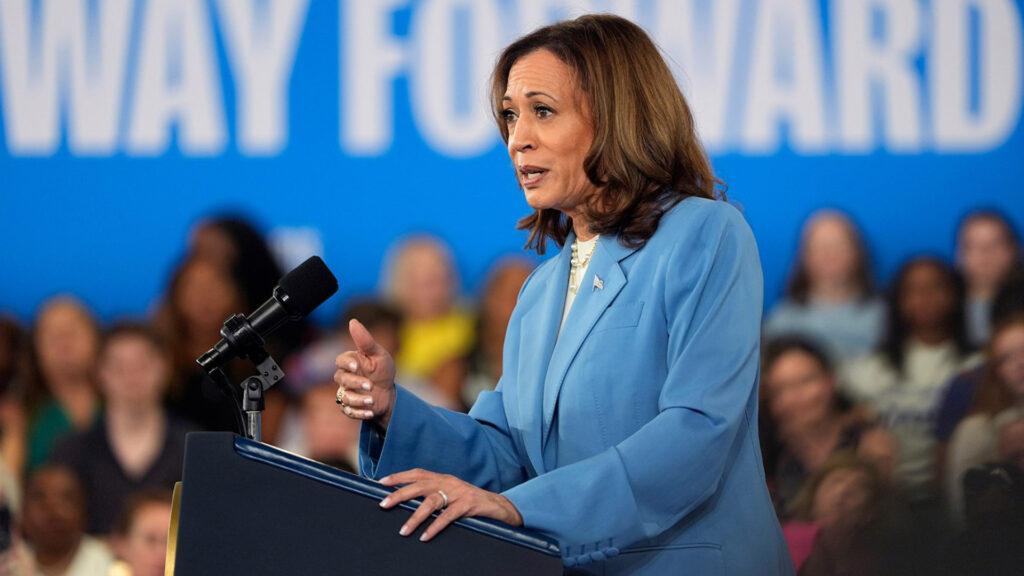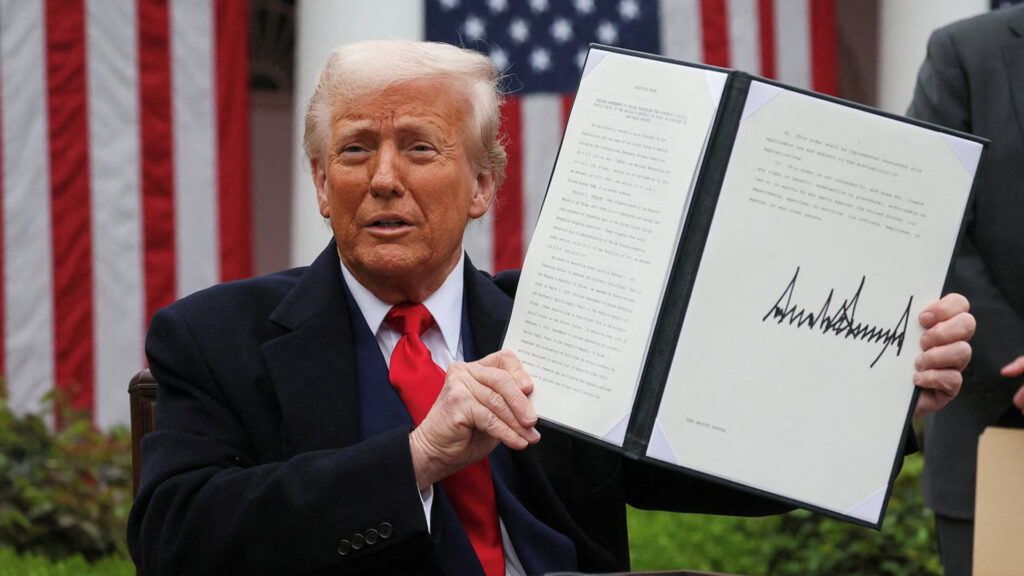As Vice President Kamala Harris steps into the spotlight as the Democratic presidential nominee following President Joe Biden’s sudden exit from the race, she faces the challenge of carving out her economic vision.
While she attempts to distance herself from certain policies she once championed under Biden, Harris’ proposals reflect both continuity and departure from the current administration’s approach.
Vice President Kamala Harris has unveiled her economic agenda in a recent speech in North Carolina, introducing the concept of an “opportunity economy.” With a focus on easing the financial burden on middle-class Americans, her plan includes measures to lower grocery and prescription drug prices, address the housing crisis, and ensure that economic growth benefits a broader spectrum of society.
Highlights
- Grocery Prices: Proposes a national ban on price gouging, particularly in food and groceries, and plans to give the FTC more authority to investigate price-fixing.
- Housing Costs: Aims to create three million new housing units within four years, providing $25,000 in down payment assistance for first-time homebuyers.
- Child Tax Credit: Proposes a $6,000 tax credit for newborns and the restoration of a pandemic-era child tax credit.
- Prescription Drug Prices: Suggests capping insulin prices at $35 and out-of-pocket expenses at $2,000 annually.
- Healthcare: Plans to expand subsidies under the Affordable Care Act and proposes canceling medical debt.
- Minimum Wage and Paid Leave: Supports raising the minimum wage and implementing 12-week paid leave.
Policy Highlights
Grocery Prices
Harris proposes a significant crackdown on price gouging within the grocery sector, a move that contrasts with her previous role in the Biden administration, where similar issues were less aggressively addressed.
Her plan includes empowering the FTC and prosecutors to target companies that engage in unfair pricing practices, particularly in meat supply chains—a sector that has faced scrutiny for alleged anti-competitive behavior. This proposal signals a tougher regulatory stance that may appeal to middle-class voters frustrated by rising food costs.
Housing Costs
Addressing the housing crisis is a cornerstone of Harris’ economic agenda. She proposes a $25,000 down payment assistance program for first-time homebuyers, alongside the creation of three million new housing units.
Her strategy also includes tax credits for developers focused on building starter homes and a $40 million innovation fund aimed at driving affordable housing initiatives. These proposals highlight Harris’ commitment to tackling housing affordability, though they raise questions about funding and implementation, especially given her prior support for less ambitious measures under Biden.
Rental Costs
Harris’ plan to expand tax credits for affordable housing developers and legislate against predatory rental practices underscores her focus on alleviating the financial burden on renters.
She aims to curb the influence of investors who drive up rental prices, an issue that has gained traction as housing costs continue to soar. However, this represents a departure from her earlier stance within the Biden administration, where similar initiatives were less emphasized.
Child Tax Credit
Building on the pandemic-era child tax credit, Harris proposes a $6,000 credit for families with newborns and a restoration of the $3,600 per child credit for middle and lower-class families.
This move is designed to provide immediate financial relief to families, though it may face resistance from fiscal conservatives concerned about the long-term impact on the federal budget.
Prescription Drug Prices & Healthcare
Harris advocates for a $35 cap on insulin prices and a $2,000 annual cap on out-of-pocket prescription drug expenses. Additionally, she plans to expand subsidies for ACA plans, potentially saving consumers up to $700 annually.
These proposals align with Biden’s broader healthcare objectives but suggest a more aggressive approach in reducing costs for consumers. Harris also aims to cancel medical debt in collaboration with states, addressing a growing concern among voters burdened by healthcare expenses.
Taxes
Harris seeks to expand the Earned Income Tax Credit (EITC) for lower-income workers, offering up to $1,250 in tax cuts. While she continues Biden’s promise not to raise taxes on households earning less than $400,000 annually, Harris also supports raising taxes on the wealthy and corporations.
This reflects a progressive tax stance that appeals to her base but may alienate higher earners and business groups.
A Comparative Perspective: Harris, Biden, and Trump
Kamala Harris’ economic agenda reflects a nuanced evolution from the policies of her predecessor, Joe Biden, and presents a sharp contrast to the approach of Donald Trump. While Harris’ focus on middle-class relief and affordability aligns closely with Biden’s values, her proposals show a willingness to take bolder steps, particularly in addressing housing affordability and tackling corporate price gouging.
Where Biden emphasized stability and incremental reforms, Harris proposes more aggressive actions, such as empowering the Federal Trade Commission to take direct action against companies that inflate prices, especially in essential markets like groceries and pharmaceuticals. Her emphasis on a significant increase in housing units and her plan to cap prescription drug costs demonstrate her commitment to addressing pressing issues head-on, rather than through more gradual adjustments.
In contrast, Donald Trump’s economic vision prioritizes tax cuts, deregulation, and protectionism, with a focus on bolstering corporate profits and reducing government intervention. Trump’s agenda often centers on stimulating economic growth through supply-side measures, such as lowering the corporate tax rate and increasing domestic energy production, which he argues will lower prices and boost employment.
Harris, however, diverges sharply from this approach, focusing on demand-side measures aimed at directly benefiting consumers. While Trump’s policies are designed to stimulate growth at the top, with the belief that benefits will trickle down, Harris’ policies aim to uplift the middle class and working families directly, with targeted tax relief and consumer protections.
This contrast in economic philosophies sets up a clear choice for voters in the upcoming election: a continuation of Biden’s steady, moderate approach with a new emphasis on aggressive consumer protection under Harris, or a return to Trump’s focus on tax cuts and deregulation, which favors corporate interests and market-driven solutions.
Industry Insights
Harris’ economic proposals are poised to have significant implications across multiple industries, particularly in housing, healthcare, and retail.
Her aggressive stance on housing affordability is likely to create new opportunities and challenges for real estate developers, as the proposed tax credits for building affordable housing could spur a surge in construction aimed at lower-income buyers and renters. This focus on housing may lead to a reallocation of resources within the real estate sector, with developers shifting their strategies to capitalize on these incentives.
In the healthcare sector, Harris’ proposal to cap prescription drug prices and expand Affordable Care Act subsidies is expected to have a profound impact on pharmaceutical companies and insurers. The cap on insulin and out-of-pocket drug expenses, combined with Medicare’s enhanced ability to negotiate prices, could pressure drug manufacturers to lower costs, potentially squeezing profit margins but making essential medicines more accessible to consumers.
Retailers, particularly in the grocery sector, will need to navigate the heightened scrutiny that Harris’ proposed anti-price gouging measures will bring. The Federal Trade Commission’s expanded authority to crack down on unfair pricing practices could lead to increased regulatory oversight, especially in markets where consolidation has led to less competition.
For small businesses, however, these measures could level the playing field, allowing them to compete more effectively against larger conglomerates.
Overall, Harris’ economic policies signal a shift towards greater government intervention in markets traditionally dominated by large corporations, with the aim of creating a more equitable economic landscape.
While these policies may introduce new challenges for certain industries, they also present opportunities for businesses that can adapt to and thrive under a more regulated, consumer-focused economic environment. Also, the success of these initiatives will depend on their implementation and the broader political landscape, especially given the mixed legacy of her tenure as Vice President.





